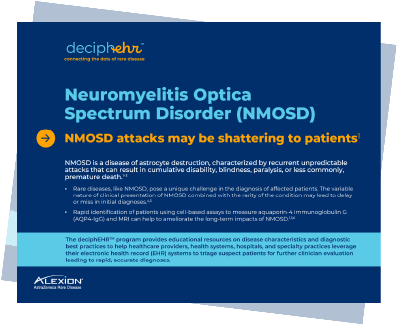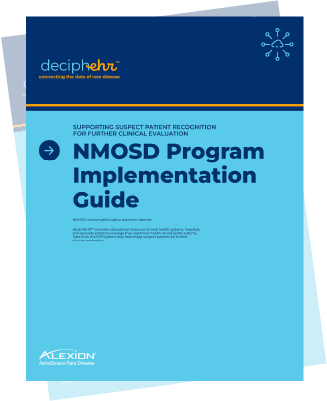NMOSD attacks may be shattering to patients1
-
NMOSD is a disease of astrocyte destruction, characterized by recurrent unpredictable attacks that can result in cumulative disability, blindness, paralysis, or less commonly, premature death1-3
- Rare diseases, like NMOSD, pose a unique challenge in the diagnosis of affected patients. The variable nature of clinical presentation of NMOSD combined with the rarity of the condition may lead to delay or miss in initial diagnosis4,5
- Rapid identification of patients using cell-based assays to measure aquaporin-4 immunoglobulin G (AQP4-IgG) and MRI can help to ameliorate the long-term impacts of NMOSD1,3,6
Take action with an NMOSD toolkit.
Leveraging EHRs may help health organizations triage patients for further evaluation7
Why is NMOSD patient recognition important?

of NMOSD patients never fully recover from their first myelitis or optic neuritis attack, indicating NMOSD is a neurological emergency/crisis. By the time of diagnosis, some patients may have already experienced multiple relapses* and have irreversible nervous system damage.1†

At 5 years after disease onset,‡ approximately 1 out of 5 patients with AQP4-IgG+ NMOSD would require a walker and 1 out of 11 patients will require a wheelchair.3

At 5 years after disease onset, almost half (41%) of seropositive patients are expected to be legally blind§ in at least one eye and 9% to be legally blind§ in both eyes.3

NMOSD has a higher prevalence and disproportionately impacts patients of Asian and African descent who may already have lack of access to the healthcare system.8-11

~43% of NMOSD patients were misdiagnosed/delayed in accurate diagnosis after initial consultation with a healthcare provider.1 Misdiagnosis often favors more common diseases that share similar presentations, such as multiple sclerosis (MS).12II
EHR=electronic health record; MRI=magnetic resonance imaging.
*The terms “attack” and “relapse” are used interchangeably.
†Retrospective study based on the German NEMOS registry that evaluated 175 Caucasian patients with NMOSD (defined by
Wingerchuk DM, et al. Neurology. 2006;66(10):1485-1489.) and known AQP4 antibody status.
‡Based on Kaplan-Meier analyses from a retrospective study of 140 patients with AQP4-IgG+ NMOSD identified from Mayo Clinic
records from 2005 to 2011 with some on therapy and some off therapy.
§Sustained visual acuity 20/200 or less for more than 6 months, with best possible correction.
||The wrong diagnosis of MS became less common after aquaporin-4 immunoglobulin G (AQP4-IgG) testing became commercially
available in 2005 (20% vs 54.2% before 2005; P<0.007).
References: 1. Jarius S, Ruprecht K, Wildemann B, et al. Contrasting disease patterns in seropositive and seronegative neuromyelitis optica: a multicentre study of 175 patients. J Neuroinflammation. 2012;9:14. 2. Kitley J, Leite MI, Nakashima I, et al. Prognostic factors and disease course in aquaporin-4 antibody-positive patients with neuromyelitis optica spectrum disorder from the United Kingdom and Japan. Brain. 2012;135(pt 6):1834-1849. 3. Jiao Y, Fryer JP, Lennon VA, et al. Updated estimate of AQP4-IgG serostatus and disability outcome in neuromyelitis optica. Neurology. 2013;81(14):1197-1204. 4. Ajmera MR, Boscoe A, Mauskopf J, Candrilli SD, Levy M. Evaluation of comorbidities and health care resource use among patients with highly active neuromyelitis optica. J Neurol Sci. 2018;384:96-103. 5. Szewczyk AK, Papuć E, Mitosek-Szewczyk K, Woś M, Rejdak K. NMOSD–diagnostic dilemmas leading towards final diagnosis. Brain Sci. 2022;12(7):885. 6. Wingerchuk DM, Banwell B, Bennett JL, et al. International consensus diagnostic criteria for neuromyelitis optica spectrum disorders. Neurology. 2015;85(2):177-189. 7. Ben-Assuli O, Sagi D, Leshno M, Ironi A, Ziv A. Improving diagnostic accuracy using EHR in emergency departments: a simulation-based study. J Biomed Inform. 2015;55:31-40. 8 Mealy MA, Kessler RA, Rimler Z, et al. Mortality in neuromyelitis optica is strongly associated with African ancestry. Neurol Neuroimmunol Neuroinflamm. 2018;5(4):e468. 9 Kim SH, Mealy MA, Levy M, et al. Racial differences in neuromyelitis optica spectrum disorder. Neurology. 2018;91(22):e2089-e2099. 10. Palace J, Lin DY, Zeng D, et al. Outcome prediction models in AQP4-IgG positive neuromyelitis optica spectrum disorders. Brain. 2019;142(5):1310-1323. 11. Hor JY, Asgari N, Nakashima I, et al. Epidemiology of neuromyelitis optica spectrum disorder and its prevalence and incidence worldwide. Front Neurol. 2020;11:501. 12. Traub J, Häusser-Kinzel S, Weber MS. Differential effects of MS therapeutics on B cells-implications for their use and failure in AQP4-positive NMOSD patients. Int J Mol Sci. 2020;21(14):5021.



